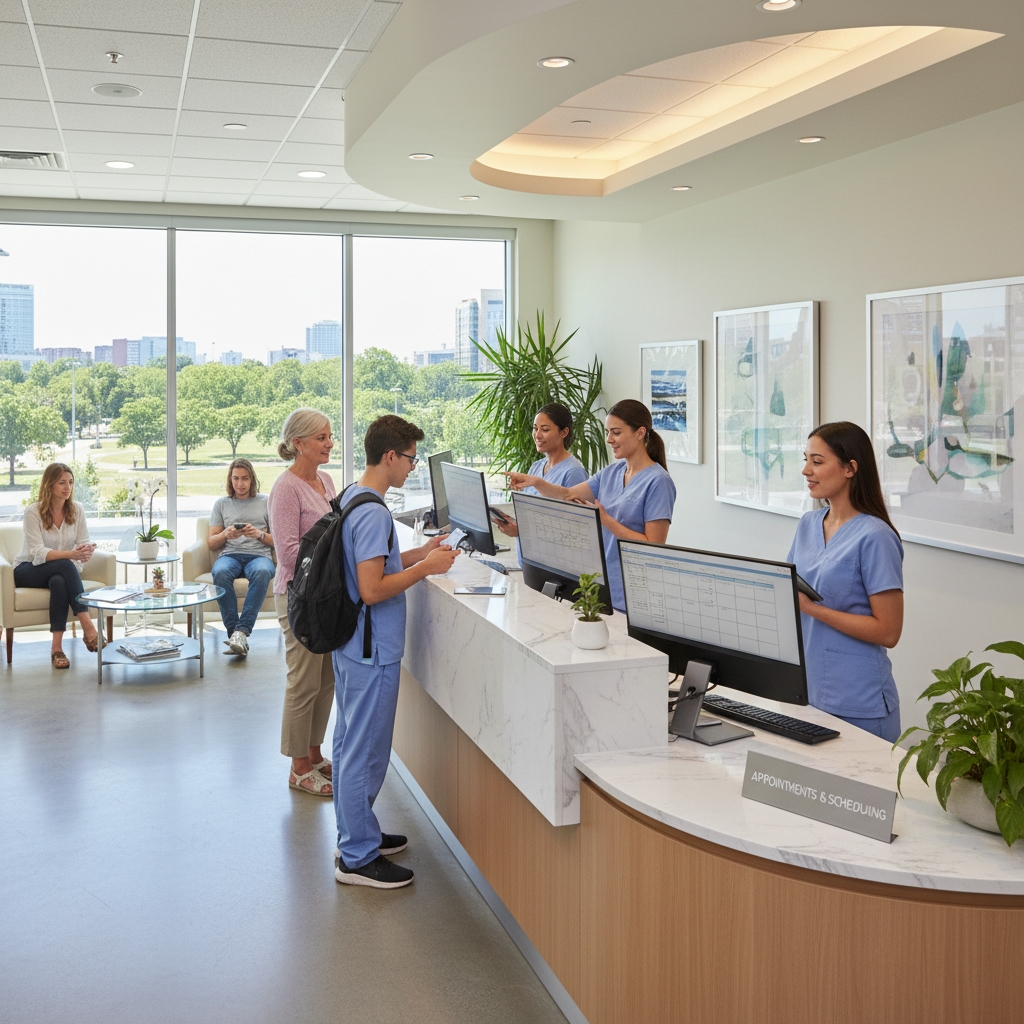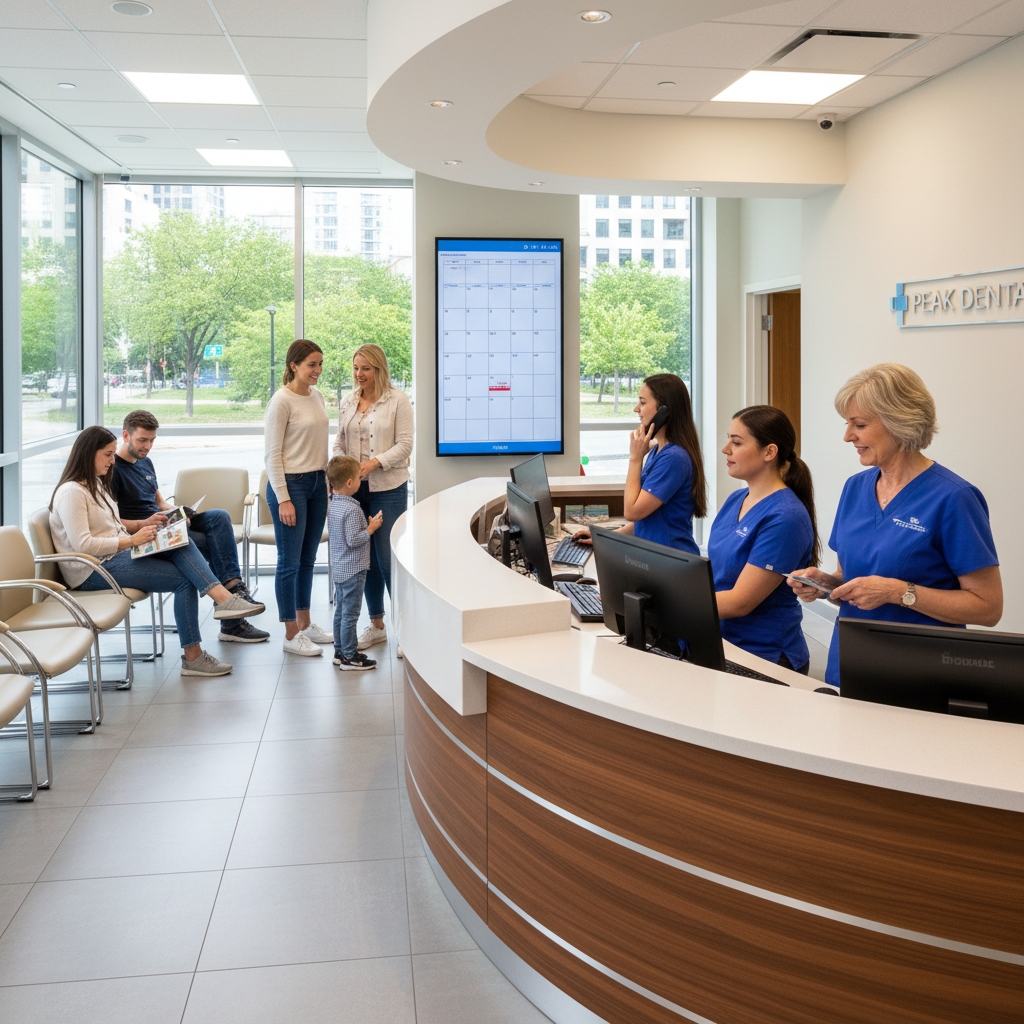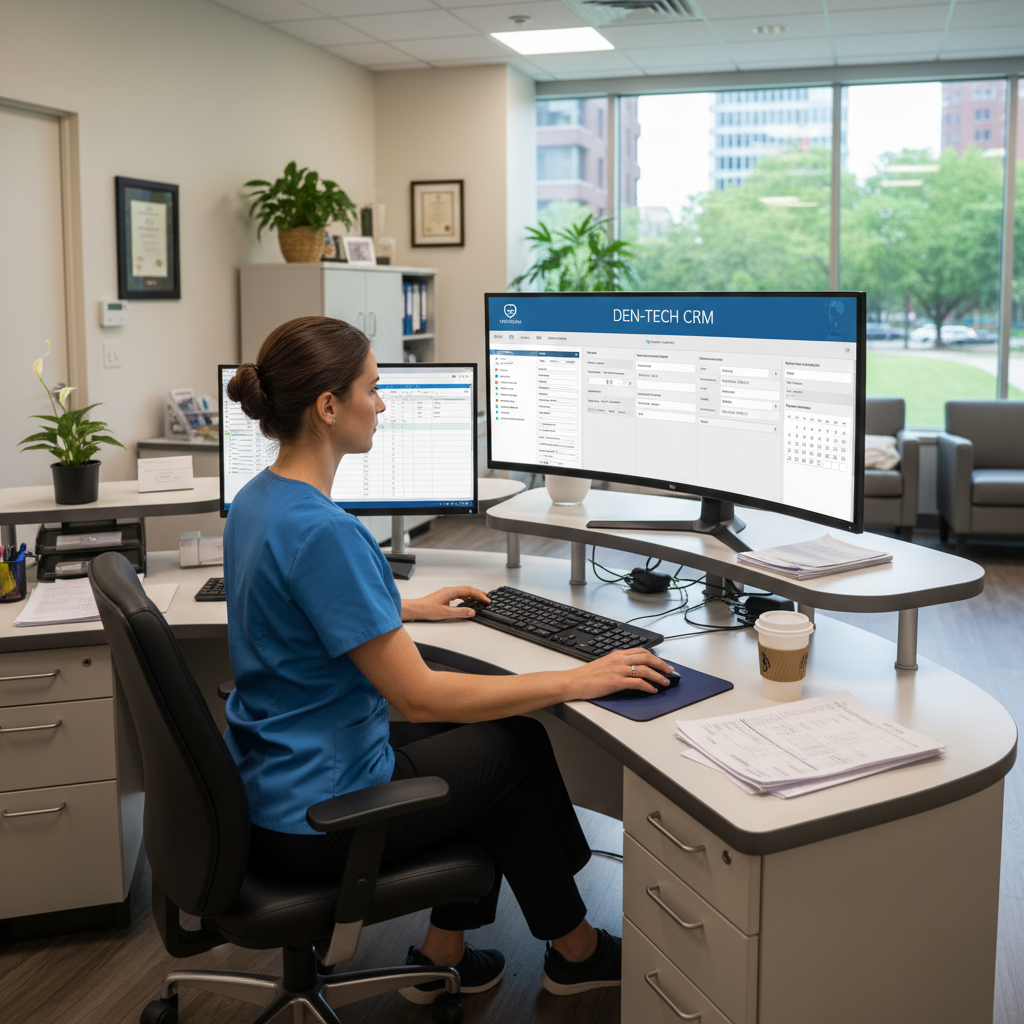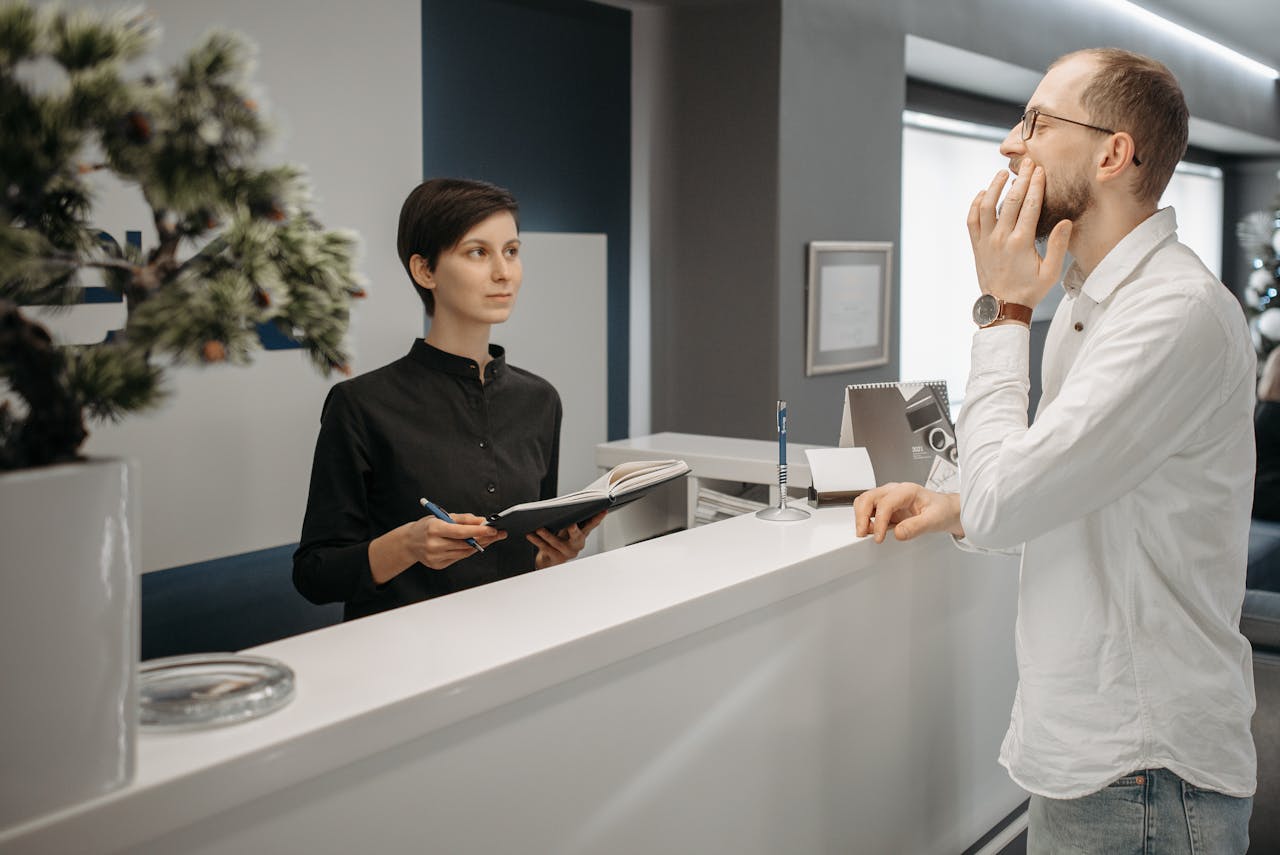












Blog Article


How to Bridge the Gap in Patient Communication During Non-Business Hours - Guide For Dentists and DSOs
Dental practices lose thousands of dollars every month when patients cannot reach them after hours. Emergency toothaches, broken crowns, and urgent dental concerns don't follow business schedules, yet most dental offices have no system to handle these critical communications.
Remote after-hours communication services bridge the gap between dental providers and patients by ensuring continuous access to care and preventing revenue loss from missed opportunities. Studies show that 80% of preventable medical errors happen because of miscommunication, making effective patient communication essential for both patient safety and practice success.
After-hours communication services provide continuity of care while reducing unnecessary emergency room visits and building stronger patient relationships. Modern dental practices and DSOs that implement comprehensive communication solutions see improved patient retention, increased treatment acceptance, and significant revenue growth through better patient engagement.
Key Takeaways
- Dental practices lose significant revenue when patients cannot reach them during emergencies or after business hours
- Automated communication solutions help maintain patient relationships and reduce unnecessary emergency room visits
- Analytics and integrated platforms allow DSOs to track communication effectiveness and optimize patient engagement strategies
Patient Communication Challenges During Non-Business Hours
Dental practices lose significant revenue when patients cannot reach them outside regular business hours. Studies show that 67% of patients expect immediate responses to their inquiries, while traditional office hours leave practices vulnerable to missed opportunities and frustrated patients.
Missed Patient Calls Statistics
Dental practices receive approximately 30-40% of their patient calls during non-business hours. Research indicates that 82% of callers will not leave a voicemail when reaching an answering machine.
The average dental practice misses 15-25 calls per week during evenings, weekends, and holidays. These missed connections represent potential new patients, emergency situations, and existing patients seeking care.
Small dental practices experience the highest impact from missed calls. Single-location offices lose an average of 8-12 new patient opportunities monthly due to after-hours communication gaps.
DSOs with multiple locations face compounded challenges. Each practice location can miss 20-30 calls weekly, creating substantial revenue losses across the organization.
Emergency dental calls peak between 6 PM and 10 PM on weekdays. Weekend emergency calls typically occur between 10 AM and 4 PM when patients notice dental pain or issues.
Impact on Dental Practice Revenue
Each missed call costs dental practices an average of $300-500 in potential revenue. New patient appointments generate higher lifetime values, making missed opportunities particularly costly.
Dental practices lose approximately $15,000-25,000 annually from missed after-hours calls. This figure increases significantly for practices in competitive markets where patients have multiple provider options.
Emergency dental situations create immediate revenue opportunities. Patients experiencing dental pain often accept same-day or next-day appointments regardless of cost considerations.
DSOs experience amplified revenue losses across multiple locations. A 10-location DSO can lose $150,000-250,000 annually from inadequate after-hours communication systems.
Patient retention suffers when practices cannot provide timely responses. Communication barriers in healthcare directly impact patient satisfaction and loyalty.
Barriers to Timely Appointment Booking
Traditional phone systems create significant booking delays during non-business hours. Patients must wait until the next business day to schedule appointments, leading to frustration and potential patient loss.
Voicemail systems prove inadequate for urgent dental needs. Patients requiring immediate attention often seek alternative providers when they cannot reach their preferred practice directly.
Staff scheduling limitations prevent extended coverage hours. Most dental practices operate with minimal administrative staff, making 24/7 phone coverage financially challenging.
Online scheduling systems face adoption barriers among certain patient demographics. Older patients often prefer phone-based appointment booking over digital alternatives.
Effective patient communication strategies require integrated approaches that address both technological and human factors. Practices must balance automation with personal touch to maintain patient relationships.
Appointment confirmation challenges increase during off-hours. Patients booking appointments through voicemail systems experience higher no-show rates due to lack of immediate confirmation and scheduling clarity.
Essential Needs for Effective Dental Office Communication
Modern dental practices require robust communication systems that operate beyond traditional office hours and streamline patient interactions. The most critical components include round-the-clock patient support, automated appointment management, and systematic follow-up protocols.
24 × 7 Response for Patient Inquiries
Dental emergencies and patient concerns don't follow business hours. Patients experiencing pain or anxiety often need immediate reassurance and guidance, even at midnight or during weekends.
A comprehensive after-hours communication system addresses urgent dental issues through multiple channels. This includes automated phone systems that triage calls based on severity and provide appropriate emergency contacts.
Key Features of 24/7 Patient Response:
- Emergency triage protocols for urgent vs. non-urgent calls
- Automated text responses with basic care instructions
- Direct routing to on-call dentists for severe cases
- Patient portal access for appointment requests
Many practices report a 40% reduction in emergency room visits when patients have access to effective communication systems. This not only improves patient outcomes but also reduces unnecessary healthcare costs.
DSOs benefit significantly from centralized communication systems that serve multiple locations. This approach ensures consistent patient care standards across all practice locations while reducing staffing overhead.
Automated Scheduling Systems
Manual appointment scheduling creates bottlenecks that frustrate patients and reduce practice efficiency. Automated systems eliminate phone tag and allow patients to book appointments at their convenience.
Modern scheduling platforms integrate with practice management software to provide real-time availability. Patients can view open slots, select preferred times, and receive automatic confirmations without staff intervention.
Automated Scheduling Benefits:
- Reduced phone volume by 60-70% during peak hours
- Increased booking conversion through 24/7 availability
- Minimized scheduling errors with automated confirmations
- Improved staff productivity by eliminating repetitive tasks
These systems also handle appointment modifications and cancellations automatically. Patients can reschedule online up to a specified time limit, freeing staff to focus on patient care rather than administrative tasks.
Integration with patient records allows the system to suggest appropriate appointment types and durations based on treatment history.
Consistent Follow-Up Reducing Patient No-Shows
Patient no-shows cost dental practices an average of $200 per missed appointment. Systematic follow-up communication dramatically reduces these losses while improving patient compliance with treatment plans.
Automated reminder systems send multiple touchpoints through patients' preferred communication channels. This typically includes initial appointment confirmations, 48-hour reminders, and day-of confirmations.
Effective Follow-Up Timeline:
- Immediate confirmation upon booking
- 48-hour reminder via text or email
- 24-hour confirmation request with response required
- Post-appointment follow-up for care instructions
Research shows that strategic communication approaches can reduce no-show rates by up to 50%. The key lies in using patients' preferred communication methods and timing messages appropriately.
Post-treatment follow-ups also serve dual purposes. They demonstrate care for patient outcomes while identifying potential complications early, reducing liability risks and improving patient satisfaction scores.
Revenue Loss From Unanswered Calls in Dental Clinics
Dental practices face substantial financial losses when calls go unanswered, with revenue impacts reaching six figures annually for many clinics. Studies show that 35% of calls in dental offices go unanswered, creating measurable revenue gaps that affect practice profitability and growth.
Revenue Attribution to Missed Calls
Each new patient generates an average of $850 in revenue during their first year with a dental practice. When practices miss just 10 new patient calls monthly, they lose approximately $8,500 in potential revenue each month.
This translates to $102,000 in annual losses from missed new patient opportunities alone. Over a seven-year patient relationship period, this figure reaches $714,000 in lost lifetime value.
Monthly Revenue Loss Calculations:
- 10 missed new patient calls × $850 = $8,500/month
- Annual impact: $102,000
- Seven-year impact: $714,000
The financial impact extends beyond new patient acquisition. Only 68% of new patient calls are answered, and just 42% of answered calls convert to appointments.
Inefficient scheduling caused by unanswered calls costs practices an additional $150,000 annually. This occurs when existing patients cannot reach the office to schedule appointments or discuss treatment plans.
Peak and After-Hours Call Trends
Dental practices experience the highest volume of missed calls during peak hours when staff members are occupied with patient care. The problem intensifies during lunch breaks and shift changes when fewer staff members are available to answer phones.
After-hours calls represent a significant missed opportunity. Research shows that 11% of patient calls occur outside standard business hours, yet most practices remain unavailable during these times.
Peak Call Times:
- Morning rush: 8:00 AM - 10:00 AM
- Lunch period: 12:00 PM - 1:00 PM
- End of day: 4:00 PM - 6:00 PM
- After hours: 6:00 PM - 8:00 AM
Many patients prefer calling outside normal business hours due to work schedules. When practices cannot accommodate these calls, patients often contact competing offices that offer better accessibility.
Emergency calls during evenings and weekends represent high-value opportunities that practices frequently miss without proper call management systems.
Appointment Recovery Opportunities
Traditional voicemail systems fail to recover most missed opportunities, with 80% of callers refusing to leave messages when reaching voicemail. This means practices lose three out of four potential appointments from missed calls.
DSOs and individual practices that implement call recovery strategies see significant improvements in appointment booking rates. Practices using automated systems report 90% call answer rates compared to 65% with traditional methods.
Recovery Strategy Results:
- Automated systems: 90% answer rate
- Traditional methods: 65% answer rate
- Revenue increase: Up to 12%
The conversion rate for recovered calls reaches 30-40% when practices contact patients within two hours of the missed call. This drops to less than 15% when follow-up occurs after 24 hours.
Practices that prioritize call recovery see measurable improvements in monthly revenue. Even recovering two to three missed calls daily can generate $3,000 to $10,000 in additional monthly revenue for most dental clinics.
Leveraging Automated Solutions for Dental Practices
Dental practice automation transforms after-hours patient communication by handling routine inquiries, managing appointments, and reducing staff burden through intelligent systems. These solutions maintain professional patient relationships while improving workflow efficiency around the clock.
Automated Text Responses and Human Tone
Modern automated messaging systems deliver natural, conversational responses that patients cannot distinguish from human staff communication. These platforms analyze patient inquiry context and respond with appropriate empathy and professionalism.
Key features include:
- Personalized greetings using patient names
- Contextual responses based on appointment history
- Empathetic language for pain or emergency situations
- Professional tone matching practice branding
Practices report significant improvements in patient satisfaction when automated responses mirror their staff's communication style. The system learns from previous interactions to refine response quality over time.
Automated text systems handle common after-hours inquiries like appointment confirmations, prescription refill requests, and basic scheduling questions. This immediate response capability prevents patient frustration from delayed communication.
Context-Aware Appointment Scheduling
Advanced scheduling automation considers multiple factors beyond basic availability, including patient history, treatment requirements, and provider preferences. The system accesses electronic health records to suggest appropriate appointment types and durations.
Smart scheduling capabilities:
- Treatment-based blocking: Automatically reserves adequate time for specific procedures
- Provider matching: Routes patients to their preferred dentist or hygienist
- Insurance verification: Confirms coverage before booking appointments
- Follow-up scheduling: Automatically books recommended return visits
The system prevents common scheduling errors by cross-referencing patient needs with provider availability. It also handles complex scheduling scenarios like coordinating multiple family members or treatment sequences.
Patients can reschedule appointments through automated prompts, reducing no-show rates and administrative phone calls. The system sends confirmation messages with relevant pre-appointment instructions.
Reducing Manual Staff Workload
Automation eliminates repetitive administrative tasks that consume significant staff time during business hours. Front office employees can focus on complex patient needs rather than routine communication management.
Staff time savings include:
- Message filtering: Automated systems handle basic inquiries before staff involvement
- Appointment reminders: Eliminates manual phone calls and text messaging
- Insurance pre-authorization: Automatic submission and tracking
- Patient intake: Digital forms completed before appointments
Practice managers report staff productivity increases of 30-40% when implementing comprehensive automation systems. Employees experience reduced stress from constant phone interruptions and can provide better in-person patient care.
The technology creates detailed logs of all patient interactions, providing staff with complete communication context when patients visit. This continuity improves patient experience and reduces miscommunication errors.
Analytics Dashboard Insights for Dental Offices
Modern dental practices need clear visibility into after-hours communication patterns to improve patient retention and staff accountability. Dental analytics dashboards transform raw call data into actionable insights that help practice owners identify communication gaps and optimize response strategies.
Missed-Call Heatmaps and Metrics
Missed-call heatmaps reveal critical patterns in patient communication attempts during non-business hours. These visual representations show peak calling times, frequency of missed opportunities, and geographic distribution of after-hours inquiries.
Key metrics to track include:
- Total missed calls per day/week/month
- Average response time to voicemails
- Call-to-appointment conversion rates
- Patient callback success rates
Heat maps display color-coded intensity showing when most patients attempt to contact the practice. Red zones typically indicate evenings between 6-8 PM and weekend mornings when patients experience dental emergencies or remember to schedule appointments.
Practices can identify staffing gaps by analyzing missed call patterns. If Tuesday evenings show consistently high missed call volumes, practices might consider extending phone coverage or implementing automated callback systems.
Revenue impact metrics help quantify lost opportunities. Each missed call represents potential revenue ranging from $200 for routine cleanings to $2,000+ for emergency procedures.
Tracking Staff Follow-Up Performance
Staff performance metrics ensure consistent patient communication standards across all team members. Dental practice analytics provide detailed insights into individual and team response effectiveness.
Performance indicators include:
Metric Target Range Impact
Callback completion rate 90-95% Patient retention
Average response time Under 2 hours Patient satisfaction
Appointment booking rate 70-80% Revenue conversion
Individual staff scorecards show callback completion rates, response times, and appointment conversion success. These metrics help identify top performers and staff members needing additional training.
Response quality tracking measures conversation length, appointment scheduling success, and patient satisfaction scores. Staff members with consistently high conversion rates can mentor others and share successful communication techniques.
Automated alerts notify managers when staff response times exceed acceptable thresholds or callback completion rates drop below targets.
Multi-Location Management Features
DSOs and multi-location practices require centralized dashboards providing comprehensive oversight across all office locations. Unified analytics platforms aggregate data from multiple sites while maintaining location-specific performance tracking.
Location comparison metrics include:
- Response time variations between offices
- Missed call rates by geographic region
- Staff performance consistency across locations
- Revenue conversion differences
Cross-location benchmarking identifies best practices from high-performing offices. If one location achieves 85% callback completion rates while others average 65%, managers can investigate successful strategies and implement them systemwide.
Regional calling pattern analysis reveals demographic differences in patient communication preferences. Urban locations might receive more evening calls, while suburban offices see higher weekend volumes.
Centralized reporting streamlines management oversight by providing executive-level dashboards showing aggregate performance while allowing drill-down capabilities for location-specific analysis. Real-time notifications alert regional managers to communication breakdowns requiring immediate attention.
Standardization tools help maintain consistent communication protocols across all locations through shared templates, response scripts, and performance benchmarks.
Integrating Patient Communication Platforms in DSOs
DSOs require seamless technology integration across multiple locations while maintaining brand consistency and operational efficiency. The most successful implementations focus on custom practice management system connections, unified branding solutions, and systematic deployment strategies.
Custom Integrations With PMS
Practice management system integration eliminates duplicate data entry and ensures accurate patient information flows between systems. Most DSOs use platforms like Dentrix, Eaglesoft, or Open Dental that require specific API connections.
Custom integrations sync appointment data, patient demographics, and treatment histories automatically. This prevents staff from manually entering information twice and reduces scheduling errors.
Key Integration Points:
- Patient appointment scheduling
- Treatment plan reminders
- Insurance verification status
- Payment processing notifications
Modern patient communication platforms can integrate with existing EHR systems to streamline operations. The integration typically takes 2-4 weeks depending on system complexity.
Real-time synchronization ensures updates made in the PMS immediately reflect in communication tools. This prevents patients from receiving outdated appointment reminders or incorrect billing notifications.
White-Label Solutions for Dental Brands
White-label platforms allow DSOs to maintain consistent branding across all patient touchpoints while using third-party technology. The communication platform displays the DSO's logo, colors, and messaging instead of the vendor's branding.
Brand consistency builds patient trust and recognition across multiple locations. Patients receive texts, emails, and portal access that match the dental office's visual identity.
Customizable Brand Elements:
- Logo placement on all communications
- Color schemes matching practice branding
- Custom messaging for appointment reminders
- Branded patient portals and mobile apps
Most white-label solutions charge additional fees for customization services. DSOs should budget 10-20% extra for branding modifications and ongoing design support.
The platform should allow different messaging templates for various practice types within the DSO network. Pediatric offices need different communication styles than oral surgery practices.
Scalable Roll-Outs Across Locations
Successful DSO implementations require phased deployment strategies that minimize disruption to daily operations. Most organizations start with 2-3 pilot locations before expanding network-wide.
The pilot phase identifies workflow issues and staff training needs before full deployment. This approach reduces implementation costs and prevents system-wide problems.
Deployment Timeline:
- Weeks 1-2: Pilot location setup and staff training
- Weeks 3-4: Data migration and system testing
- Weeks 5-6: Performance monitoring and adjustments
- Month 2+: Gradual rollout to remaining locations
Healthcare communication platforms require standardized training protocols across all locations. Staff members need consistent instruction on system features and patient interaction procedures.
Centralized reporting dashboards allow DSO administrators to monitor adoption rates and communication metrics across locations. This data helps identify locations needing additional support or training.
Volume-based pricing models typically offer better rates as more locations join the platform. DSOs should negotiate pricing tiers that decrease per-location costs as they expand their network.
Enhancing Patient Communication With Resonate
Resonate transforms after-hours patient communication through empathetic outreach campaigns, intelligent scheduling automation, and measurable performance tracking. These integrated features help dental practices recover lost revenue while maintaining patient relationships around the clock.
Empathetic Outreach to Recapture Lost Revenue
Resonate's empathetic outreach system identifies patients who have missed appointments or fallen behind on treatment schedules. The platform automatically sends personalized messages that acknowledge patient concerns while encouraging them to return.
The system tracks patient communication preferences and timing. Messages arrive via text, email, or voice calls based on individual patient preferences. This targeted approach increases response rates compared to generic reminder systems.
Key outreach features include:
- Customizable message templates for different scenarios
- Automated follow-up sequences for non-responders
- Integration with practice management systems
- Multi-channel communication options
Dental practices using empathetic outreach typically see 15-25% increases in appointment bookings from previously inactive patients. The system helps practices recover patient volume through strategic communication timing and messaging.
AI Agents for Scheduling and Engagement
Resonate's AI agents handle appointment scheduling, rescheduling, and basic patient inquiries during non-business hours. These agents understand dental terminology and can answer common questions about procedures, insurance, and office policies.
The AI system integrates directly with existing practice management software. Patients can book appointments, request prescription refills, or ask questions through text messages or online chat interfaces.
AI agent capabilities:
Function Description Availability
Appointment booking Schedule routine cleanings, consultations 24/7
Emergency triage Route urgent cases appropriately 24/7
Insurance verification Check coverage and benefits Business hours + evenings
Treatment reminders Send pre-appointment instructions Automated
The AI agents learn from patient interactions to improve response accuracy over time. This reduces staff workload while ensuring patients receive immediate assistance outside normal office hours.
Transparent ROI and Performance Tracking
Resonate provides detailed analytics showing exactly how communication improvements affect practice revenue. The dashboard tracks metrics like appointment conversion rates, patient retention, and revenue recovery from outreach campaigns.
Practice owners receive monthly reports showing which communication strategies generate the highest returns. The system tracks patient engagement across all touchpoints to identify the most effective messaging approaches.
Performance metrics include:
- Appointment fill rates - Percentage of available slots booked
- Patient reactivation - Previously inactive patients returning to practice
- Revenue attribution - Direct revenue linked to communication campaigns
- Response times - Average time to patient inquiry resolution
The platform calculates ROI by comparing communication costs against recovered revenue. Most dental practices see 300-500% return on investment within the first six months of implementation, with improved patient experiences contributing to long-term practice growth.
Frequently Asked Questions
Dental practices face unique challenges in maintaining patient communication outside regular business hours. These solutions address common concerns about after-hours patient support, emergency protocols, and maintaining professional standards while providing round-the-clock accessibility.
What strategies can dentists and DSOs implement to maintain consistent communication with patients after hours?
Dentists can establish multiple communication channels to ensure patients receive timely responses during evenings and weekends. Text messaging systems allow patients to send non-urgent questions that staff can address the following business day.
Email auto-responders provide immediate acknowledgment of patient inquiries while setting clear expectations for response times. The message should include emergency contact information and typical response timeframes for different types of questions.
DSOs benefit from implementing centralized patient communication systems that route after-hours messages to appropriate team members. This approach ensures consistent messaging across multiple practice locations.
Voicemail systems should include detailed instructions for emergencies versus routine questions. Patients need clear guidance on when to seek immediate care versus waiting for regular business hours.
How can automated systems be utilized to enhance patient communication during non-business hours?
Automated chatbots can handle routine inquiries about office hours, appointment scheduling, and basic post-treatment instructions. These systems provide instant responses to common questions without requiring staff availability.
Text message automation allows practices to send appointment reminders, post-treatment care instructions, and follow-up surveys outside business hours. Patients receive timely information when they need it most.
Automated phone systems can triage calls by having patients select options for different types of inquiries. Emergency calls get routed to on-call providers while routine questions generate automatic responses with next-day callback promises.
Patient portals with automated features enable patients to access their treatment plans, payment information, and educational materials 24/7. This reduces the volume of after-hours calls for basic information requests.
What are effective protocols for managing emergency patient inquiries outside of regular office times?
Dental practices should establish clear definitions of what constitutes a true dental emergency versus urgent concerns that can wait until morning. Written protocols help staff and patients understand appropriate response levels.
Emergency contact systems must provide patients with direct access to on-call dentists for severe pain, trauma, or infections. This typically involves a dedicated emergency phone line with specific instructions.
Triage protocols help determine which situations require immediate attention versus pain management advice until the next business day. Staff training ensures consistent application of these guidelines across all patient interactions.
Partnership agreements with local emergency rooms or urgent care centers provide backup options when the on-call dentist is unavailable. Patients need clear instructions about when and where to seek alternative emergency care.
Can establishing a virtual reception service improve patient response times and if so, how?
Virtual reception services extend practice availability beyond traditional business hours without requiring additional in-house staffing. These services can handle appointment scheduling, basic inquiries, and emergency call routing.
Response times improve significantly when virtual receptionists can immediately address patient concerns rather than relying on voicemail systems. Patients receive human interaction even during off-hours.
Cost-effectiveness makes virtual reception attractive for smaller practices that cannot justify 24/7 in-house staffing. DSOs can implement these services across multiple locations for consistent patient experiences.
Integration with practice management software allows virtual receptionists to access schedules, patient information, and protocols. This ensures they provide accurate information consistent with practice policies.
In what ways can a dentist ensure the security and confidentiality of patient information when communicating remotely?
HIPAA-compliant communication platforms encrypt all patient data during transmission and storage. Dental practices must verify that all remote communication tools meet federal privacy requirements.
Staff training on remote communication security prevents accidental breaches of patient confidentiality. Team members need clear guidelines about what information can be shared through different communication channels.
Access controls limit which staff members can view patient information during remote communications. Role-based permissions ensure only authorized personnel handle sensitive patient data.
Regular security audits of remote communication systems identify potential vulnerabilities before they become compliance issues. Healthcare automation systems require ongoing monitoring to maintain security standards.
What role does patient education play in reducing the need for after-hours communication in dental care?
Comprehensive pre-treatment education reduces post-procedure anxiety calls by preparing patients for normal healing processes. Written instructions with clear timelines help patients distinguish normal symptoms from complications.
Post-treatment care packets should include detailed information about pain management, dietary restrictions, and warning signs that require immediate attention. Well-informed patients make better decisions about when to contact the practice.
Educational videos and written materials about common procedures help patients understand what to expect during recovery. This proactive approach significantly reduces unnecessary after-hours calls.
Follow-up appointment scheduling at the time of treatment reduces patient uncertainty about next steps. Clear communication about post-treatment timelines helps patients feel more confident during the healing process.
Similar Articles
Ready to Get Started
Have Questions?
We're Here to Help
Connect with our team for personalized guidance
No setup fees, cancel anytime.
.avif)

.svg)
.svg)


